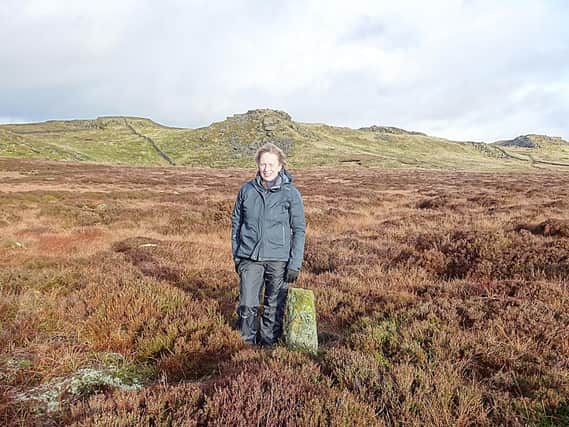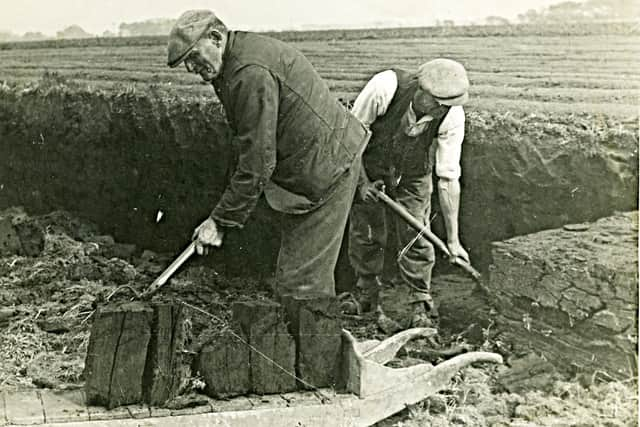A new book charts the history of peat cutting in the Upper Hodder Valley


Having previously ventured into the subject matter of old sheepwashes and limekilns for her two earlier works, Helen said her latest efforts and research were inspired by her sadly now late father-in-law Alwyne Wallbank who was born at Halsteads Farm, where Helen and her husband Stephen farm today with a flock of Dalesbred and Swaledale breeding ewes and a commercial flock.
“Alwyne would tell me of peat cutting and how he used to cut turf by hand until 1957,” said Helen. “This book would never have come about without him telling me that with traditions like this dying, peat cutting is now just on the edge of people’s memories.
Advertisement
Hide AdAdvertisement
Hide Ad“I decided it would be best to start recording memories of it and a lot of the people I talked with remembered the practice as children helping their parents on the fells.”


Photographs in the book of Tom Brennand and his son Steven of Moor Cottage, Keasden gathering turf in the 1920s show how it was moved by barrow, stacked to dry and then loaded on to a wagon to take home.
Another shows Jack Nicholson and his son James cutting the turf on Pilling Moss during the 1950s.
Peat cutting, or turf cutting as it was known in certain areas, was a practice common in moorland areas throughout Yorkshire, Lancashire and the rest of the North of England and was an important means of fuel for both heating and cooking for centuries, as well as for the drying of corn in kilns at mills, smelting of lead and burning kilns.
Advertisement
Hide AdAdvertisement
Hide AdHelen has also included a photograph showing a peat store at Blakethwaite lead smelting mill in Gunnerside Gill in Swaledale.
Helen said: “Much has been written lately about the value of peat with its ability to store carbon and how it can act as sponge absorbing water to prevent flooding further down in the valleys.
“But in years gone by it has also been said that it was more important to get the turf in than it was to get the hay in for the animals, because with no means of cooking a family may have starved.
“Turf cutting was generally undertaken in late May and into June after the lambing season.
Advertisement
Hide AdAdvertisement
Hide Ad“Often turf cutting would begin at the face where it had been left from the previous year’s cutting. Turf pits, as they were called, were usually at the top of a hill.”
Individual specialist equipment was designed by farmers for cutting peat/turf and in Helen’s booklet she has included a design referred to as an Upper Ribblesdale turf spade of the type used in the Upper Hodder Valley. Its blade measured 10 inches wide and deep with the wing two inches square to remove a block of similar proportion. This was understood to be the peat cutting standard.
Helen’s newly released booklet also shows her husband Stephen holding the turf barrow his grandfather used to transport the newly cut blocks of turf in order to dry.
“They would first be laid flat and then after a week or so turned on their edge, placed at angles to rest one against another in an act that was called ‘setting the turves’,” said Helen. “They shrank considerably during drying and became hard. At Halsteads we had a turf house where they were kept.
Advertisement
Hide AdAdvertisement
Hide Ad“Alwyne and others told me they burned slowly and hot with a pleasant sweet smell but that they were often the scourge of the housewife with fine white ash settling all around the kitchen.”
Peat cutting or turf cutting has not disappeared completely. Some still maintain the tradition, although it is not now generally handled in the same way that Helen’s father-in-law and others she interviewed recalled, but more on an industrial scale particularly in peat bogs.
Peat is sometimes referred to as the forgotten fossil fuel. Scandinavia and the British Isles are where most peatlands are harvested for fuel use with Ireland, Scotland and Finland today being the largest consumers of peat as fuel.
Carbon storage currently being a massive issue in the fight for a better, more sustainable planet, has meant that peat restoration is currently being focussed on more heavily.
Advertisement
Hide AdAdvertisement
Hide AdSarah Robinson, of the Forest of Bowland AONB Team, who have provided funding for the booklet, writes in the booklet of the work that is now being undertaken to ensure peat’s comeback, not as a fuel resource but for its greater value to the planet.
“The Forest of Bowland lays claim to some of the best blanket bog in England and supports a range of scarce plant and animal species.
“As well as supporting upland habitats and wildlife our peatlands are hugely important for a range of reasons.
“Peat stores carbon. The peatlands of England contain more carbon than the forests of Europe and keeping them healthy prevents carbon being released into the atmosphere.
Advertisement
Hide AdAdvertisement
Hide Ad“Over the last ten years we have been working with partner organisations and local landowners to restore damaged areas.”
Helen’s latest booklet is probably her most important to date as it not only records a practice that kept many families alive and well through providing heat to stay warm and the ability to cook food, it also serves to set the spotlight on a subject matter that could provide much debate on our future.
“I have always had a keen interest in local history,” said Helen. “I am also particularly pleased that on seeing a draft of this booklet the Forest of Bowland AONB were keen to get involved, for which I am grateful.
“This is and always was intended as a historic document.”
The archives